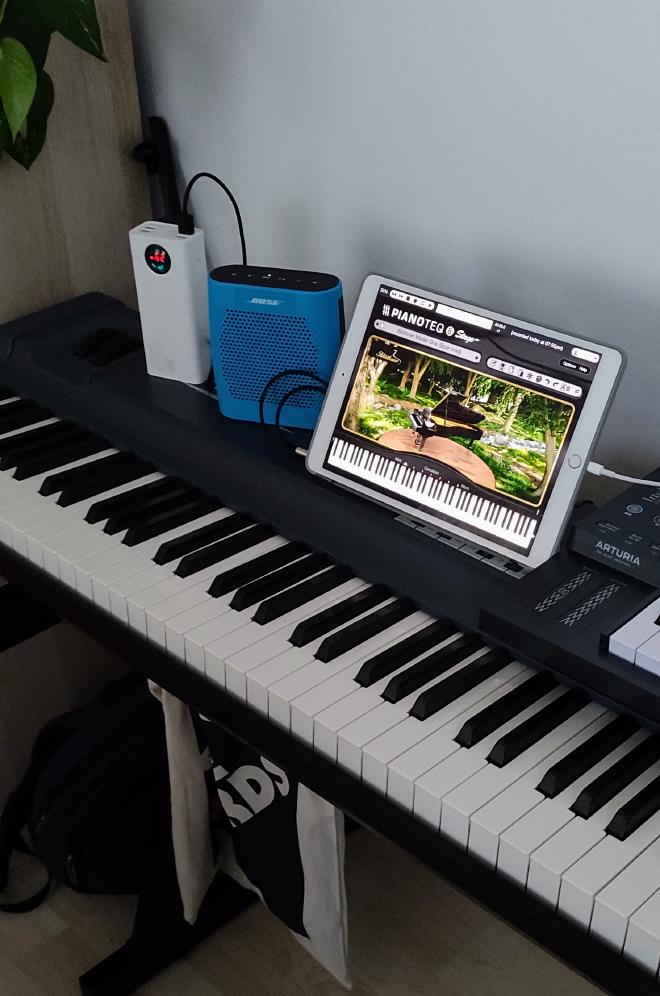Piano updates

Writing about software pianos is a very old tradition on this blog: in 2007, I compared piano sample packs, and in 2009, I wrote about the new features in Pianoteq 3. Since then, a whole lot of things have happened that I should really share now.
In 2022, a good 13 years after I played with Pianoteq for the first time, I finally bought the Pianoteq 8 Stage, and built a piano server for it based on a Raspberry Pi 4, just to have a digital piano that I can leave running all day. In the meantime (as you will see below) this became unnecessary, but there are a couple of interesting facts that I need to highlight that I realized through this:
- Pianoteq has a MIDI archiving feature. It automatically saves everything you play into MIDI files, so there’s no way you can lose that cool improvisation you did, even if you forget to hit record. As a music producer, this is pure genius, a life-saving feature for collecting ideas. (BTW, it can also render a MIDI file into audio with a given preset, so you don’t need a DAW for exporting those ideas into audio.)
- The fact that Pianoteq runs on Raspberry shows that they paid attention to run on Linux - respect. But it’s not just about any Linux implementation, they seem to really get it: Pianoteq can run in headless mode (i.e. without a graphic interface), and they even provide a JSON-RPC remote control for it (so you can e.g. run it headlessly and control it from your phone). No joke, it’s really a piano server - it’s a proper server, which also does sound 😂
In the Pianoteq Stage package, you can select two piano models: I chose the Steinway Model D and the Blüthner. Hard to say which one I like more, depends on the situation… Anyway, it’s certain that Pianoteq covers all my needs towards software pianos. From this point on, it’s only a matter of hardware. My current setup is:
- My good old Studiologic SL-990XP - yeah, the same guy I wrote about in 2007 😂 Even though the action feels good, electronically it’s quite outdated. No aftertouch, no proper velocity curve settings, oldschool 5-pin MIDI, and what’s the most painful for serious piano players, it doesn’t handle continuous sustain input at all - so, no half-pedalling. But I could patch up some of those issues with a couple of gadgets.
- To be able to use it through USB, in 2022, I bought a M-Audio Midisport UNO. I mean this weird blue soap-like thing. This is probably the most simplistic MIDI interface you can ever imagine, and the best part is, it works with anything you can imagine: Win, Mac, Linux, Android, iPad, …
- It took me months to solve the pedal issue, when I finally found the little Polish company beat bars, who make quite a few MIDI pedal gadgets, most importantly for me, the E&F2M, which is a programmable, dedicated MIDI interface for an expression pedal (and a footswitch). I bought a Roland FP-10 pedal, which is continuous, set up the E&F2M to emit sustain MIDI CC from it, and with that, finally I had a decent halfpedalling-capable pedal for the Studiologic.
I’ve been using this Raspberry-based setup for 2+ years… until 3 hours ago. The realization came very gently (just like an average lightning bolt) that I should really take a look at the iOS version of Pianoteq and how much it would cost for me. It was not yet available when I built this setup, and it never occured before that I should read about it. So, I never realized that…
…as a Pianoteq Stage license holder, I could use it for free.
…and that all the gadgets mentioned above work with my old iPad Pro perfectly well.
…which would give me the touchscreen control that I was wondering about for the Raspberry.
…and which has much better performance than the Raspberry Pi 4, of course! So: better sound, more poliphony, less latency.
Let’s just say, for me, this is easily the biggest sound technology facepalm moment of 2025 so far 🤣